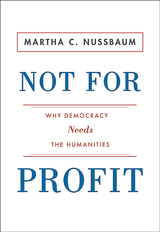 |
| Picture: Princeton University Press |
Martha C. Nussbaum
Not for Profit: Why democracy needs the humanities Princeton: Princeton University Press 2010
An ascendant philistinism sees the academic study of the arts and humanities as obscurantist and irrelevant. They say we need only science, technology, engineering and medicine; the rest are luxuries we can't afford. Martha Nussbaum is right: the humanities need defending. But they especially need defending from false friends like Martha Nussbaum. This nasty little book makes the case for using the humanities to turn everyone into good liberal cosmopolitans. The argument is tendentious and divisive, and it just replaces one kind of narrow instrumentalism with another.
Nussbaum treats the humanities as a tool kit we can use to teach 'skills' necessary for democracy as if democracy emerged from the classroom. But hers is a very particular kind of democracy that defines away conservative ideas as inherently alien. For example, it's "crucial" that we "think well about political issues affecting the nation, to examine, reflect, argue, and debate, deferring to neither tradition nor authority" (p. 25). The term 'thinking well' is double edged; she means thinking morally as well as thinking effectively. At some level that's a truism - who want to think badly? But reading on, Nussbaum's idea of 'thinking well' means 'thinking as a liberal'. The rich tradition of conservative political theory is replete with claims about the value of deferring to tradition and authority. Of course that tradition is contested, but Nussbaum sees it simply as a bad habit that can be un-learned if you take a few courses in the humanities. Having ruled much of American political culture to be bad thinking, democracy seems to be what happens when the Democratic Party has an internal debate.
Nussbaum defends platitudes about niceness against arguments of pantomime villains, telling us that we need to see fellow citizens as "people with equal rights ... not just as tools to be manipulated for one's own profit" (p,25). No doubt some people do regard others as tools to be manipulated for profit (even some people with liberal arts degrees, I suspect), but there is no public argument couched in such crass terms.
She talks about the "pathology" of dividing the world into pure and impure (p.35), which is responsible for much "bad thinking" about international politics (p. 35). That's another swipe at conservatives, implying familiarity with Jonathon Haidt's widely discussed research on the link between conservative politics and feelings about purity and pollution. But it's unimaginative to link this "pathology" with racism, which is now almost universally reviled, rather than recognising its contemporary manifestations such as health zealotry. Surely the best example of the politics of purity today comes from anti-tobacco campaigners, although it's associated with liberalism rather than conservatism. I wonder if Nussbaum would criticise the public health lobby for its pathological belief in purity, or give it a pass because they're otherwise good liberals.
I despise Nussbaum's sanctimonious liberalism, I resent her bigoted rejection of illiberal ideas and I'm bored by her conventional and old-fashioned political causes. Now let me turn to the plain badness of her argument:
"abilities crucial to the health of any democracy internally, and to the creation of a decent world culture capable of constructively addressing the world's most pressing problems ... are associated with the humanities and the arts: the ability to think critically; the ability to transcend local loyalties and to approach world problems as a 'citizen of the world'; and, finally, the ability to imagine sympathetically the predicament of another person" (p.7, my emphasis).
More anti-conservatism: does 'decency' really require transcending local loyalties and acting as a citizen of the world? Conservatives who value local associations above abstract global citizenship are no less 'decent' than liberal cosmopolitans. But focus on the weakness of the argument here, manifest in the bit I emphasised - an association is asserted, but no causation is explained. Throughout the book Nussbaum asserts the values that are needed in the polity, and tells us that these values are inculcated by study of the humanities. An ability to think critically is useful, and it's something you develop through studying the humanities - that's true, but trite. How do the views and abilities of students change after studying the humanities? To what extent is the impact of studying the humanities mediated by the kind of students who choose humanities courses? A few science courses might help Nussbaum learn how to gather some relevant evidence for her claims.
Not for Profit is an ironic title for a book written by a professor at the University of Chicago, which is the sixth most expensive college in the US (around $60k a year). And it's third for professors' salaries (average $184k). Having pecuniary interest in a debate doesn't make you wrong, but Nussbaum is excessive in the claims she makes on her own behalf. It's commonly thought that the purpose of universities is economic - training a workforce that can compete globally. That view favours investment in scientific and professional subjects at the expense of the arts and humanities. Nussbaum's alternative is cynical; she just offers a different outcome (ethical and effective politics) that she asserts is better served by the humanities. Both approaches are instrumental, treating education as a means to achieving an external end. Many of the advocates of these positions have their noses in the trough; they are arguing for more cash. A plague on both their houses; the purpose of education is to become educated. It is its own end.
Conservatives have often criticised academia's liberal bias (Roger Kimbell's
Tenured Radicals, Thomas Sowell's
Intellectuals and Society, for example).
I've always thought they were a bit paranoid, and the more populist rendition of these arguments sometimes slips into plain philistinism. But Martha Nussbaum seems to be playing up to their caricature of liberal bigotry. Her intolerant liberalism and self-interested advocacy is a poor example of how to behave in the public sphere.





